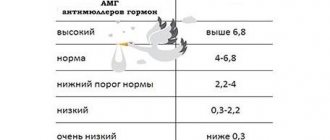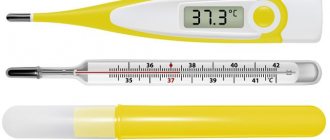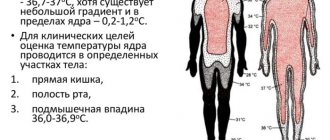Determining basal temperature is a good way of self-monitoring your body, allowing you to determine with a high degree of probability the most favorable days for conception, calculate the start date of your next period, monitor the functioning of the ovaries, and identify disturbances in the functioning of the reproductive system.
For many women, the reason for determining basal temperature is a planned pregnancy.
Let's figure out what this term means and how to measure basal temperature.
BT is measured in a state of absolute rest either in the oral cavity, or in the vagina, or in the rectum using a conventional thermometer. Based on its indicators, one can judge the processes occurring in a woman’s reproductive system.
A change in hormonal levels, which causes an increase in basal temperature (if the woman is healthy), is one of the very first signs of pregnancy. It must be remembered that an increase in general body temperature associated with various diseases leads to a distortion of the BT indicator.
As you know, most women have a menstrual cycle of 28 days. The moment of ovulation divides it into the first and second phases. If you have a non-standard menstrual cycle: short or long, then only the duration of the first phase increases.
During this period, the normal value for basal temperature will be less than 37 C. Ovulation occurs approximately in the middle of the cycle, and the BT indicator increases by 0.4 - 0.6 C. The temperature will be increased throughout the second phase, and will decrease in one to two days before menstruation by about 0.3 C.
Keep in mind that to obtain more complete information, it is recommended to measure your basal temperature several cycles in a row. An important condition - do not under any circumstances change the method of measuring it. That is, if you took measurements in the rectum, then you should measure it in the same way further.
What is basal temperature?
This term, in preparation for and during pregnancy, is firmly part of every woman's vocabulary, so it seems that it is somehow connected with reproductive health. In fact, the word “basal” only means “basic, basic” and emphasizes the following fact: during the day, the body temperature of any person can vary significantly. After a gym session or a hearty lunch, it will be higher than while watching the news while lying on the couch. Temperature measured during the day carries little information about a person’s condition; only the lowest temperature point during the day matters, and it is this that is called basal.
Basal temperature is measured at the moment of greatest relaxation - in the first minutes after waking up, and a graph of its changes over several days can tell a lot. Particularly during the menstrual cycle, it can help calculate the day of ovulation.
Significance of indicators
A woman’s menstrual cycle is influenced by the ratio of certain sex hormones: estrogens, progesterone, prolactin, hCG, etc. The regularity of menstruation and a woman’s ability to conceive a child depend on their balance. Normally, the duration of the period between menstruation is from 28 to 36 days. Because of this, it is impossible to say with certainty on what day a girl will ovulate. Every woman of reproductive age is recommended to keep her own calendar in order to increase the chance of conceiving a child or avoid unwanted pregnancy.
Find out whether it is possible to conceive during menstruation in the article at the link.
Basal temperature provides information about the functioning of internal organs. It is determined in the morning, after waking up. Any physical activity before taking measurements will negatively affect the information content of the result obtained.
The indicator is measured only in those cavities that are connected to the internal parts and systems: mouth, vagina and anus.
What basal temperature should be during ovulation?
A woman’s body temperature during reproductive age changes under the influence of hormones, and it is not always equal to the classic 36.6 °C. The basal temperature already in the early stages of pregnancy rises to a more comfortable temperature for the fetus - slightly above 37 °C. However, it is much more important to understand how it behaves during the menstrual cycle: along with the concentration of luteinizing hormone in the blood and urine, a change in this indicator is one of the main signs of ovulation.
With the onset of menstruation, the basal temperature rises slightly, then drops to normal and remains at this level throughout the first phase of the menstrual cycle. Just before ovulation, due to rising estrogen levels, it briefly dips below normal. From the moment of ovulation, the production of estrogen decreases and progesterone increases, so the temperature rises sharply above the initial level and stays there throughout the second phase of the cycle, slowly decreasing every day.
The changes described above at the beginning of a possible pregnancy are, in fact, minimal - we are talking about fractions of a degree. However, a characteristic pattern in which the temperature “dives” down and then quickly “climbs” to new heights makes it possible to detect ovulation. This means preparing for the long-awaited conception.
Types of thermometers
It is almost impossible to find out by touch whether the temperature is high or low. Therefore, a special measuring device appeared - a thermometer. Today, three types of devices are used in medical institutions and at home: with an infrared measurement method, electronic and mercury-filled.
Mercury thermometers are very accurate devices, but also very dangerous due to their contents and glass housing. Electronic thermometers that combine accuracy and speed of measurement, as well as many additional functions, help you avoid unnecessary risk. For example, the Beurer FT 15/1 express thermometer measures the temperature in just 10 seconds, beeps when the measurement is completed or the reading has increased and stores the last value in memory.
Infrared thermometers appeared relatively recently. Such a device determines the temperature in a certain area of the body in a few seconds using a non-contact method. Its operation is based on infrared radiation, which also allows you to measure the temperature of the air or any objects, for example, bottles with a mixture.
How is basal temperature measured during preparation for pregnancy?
We will not give you false hopes and tell you that this is an easy task. Not at all: it requires high discipline, attentiveness and strict adherence to the rules. We are talking about the need to detect almost imperceptible fluctuations of a fraction of a degree, and any error in measurements can become critical. It's best if you get training from your doctor, but we'll also give you a guide with 10 main principles for measuring basal temperature in preparation for and in early pregnancy.
- Only a very accurate thermometer is suitable for measurement. It is best if it is a modern digital device. Read the operating instructions carefully and do not forget to change the batteries in a timely manner. The thermometer cannot be changed during the menstrual cycle - individual errors of different devices can distort the picture.
- Measurements are best taken in the rectum. Measurements in the vagina or mouth are acceptable, but the rectal method is considered to be the most reliable. Whatever method you choose, do not change it during the cycle. Armpit measurements are not suitable for tracking ovulation because they do not provide the necessary accuracy.
- Measurements are taken only in the morning, immediately after waking up. You cannot get out of bed or make sudden movements; even a short trip to get a thermometer and back to the other end of the room can ruin everything. Prepare a thermometer the night before and place it so that it is at arm's length.
- To avoid spoiling the readings, lie still and do not change your position. Try to do everything to prevent the brain, and after it the body, from switching to “work speed” - do not think about plans for the day, about important matters and problems. Ideally, don't even open your eyes.
- Basal temperature should be measured every day at approximately the same time. A schedule in which you get up, for example, at 6 am on weekdays, and at 10 am on Saturday and Sunday, is not suitable. To ensure the necessary accuracy, you will have to set the alarm clock at 6 a.m. on weekends, or at most 7 a.m.
- The measurement should be taken after 3 or more hours of restful sleep. Try to eliminate all factors that can interrupt your sleep, in particular, do not drink a lot of fluids in the evening so that you do not have the urge to go to the toilet at night. If you slept less than 3 hours, the result may be significantly distorted.
- Measuring your basal temperature during the day when preparing for pregnancy is only possible in extreme cases, for example, if you work night shifts. Before this, you need to sleep at least 3 hours. And, of course, if you are planning to get pregnant, you need to change your work schedule or move to another job.
- Once the measurements are completed, immediately write down the result. Don't rely on memory - in the time it takes to visit the toilet or put on the kettle, the brain can switch to some important thought, and the numbers will fly out of your head. It is best to record measurements electronically. Microsoft Excel or another similar program will allow you to automatically draw a basal chart in preparation for pregnancy, which is much more visual than just a column of numbers on a piece of paper.
- Please make comments about any unexpected deviations in measurements. If you understand what led to them, write down the reason. This could be a slight illness, alcohol, sex before bed, taking certain medications, stressful conditions, severe physical activity and some other factors.
- If you catch ARVI, flu or another disease that causes your body temperature to rise significantly, feel free to stop taking measurements. While the immune system is fighting the disease, you will not see anything useful on the chart. Also, measurements are absolutely meaningless when taking oral contraceptives.
How to measure basal temperature during pregnancy?
In exactly the same way as when planning a pregnancy. It is advisable that you use the same thermometer - if it “lies” a little, at least the readings will be overestimated or underestimated in the same direction as before.
The temperature chart during pregnancy is, in fact, nothing interesting. The most comfortable temperature for fetal development is 37.0–37.3 °C, and your body will try to maintain it throughout the entire period of gestation. Basal temperature in pregnant women can change significantly only in case of pathologies, for example, with a frozen pregnancy or a threat of miscarriage. However, in such situations, the body lets you know that something has gone wrong with nagging pain in the lower abdomen or bleeding. In this case, you should not wait until the morning to take measurements: any dangerous symptoms are a reason to immediately contact your doctor.
Hyperprolactinemia
Due to an increase in the level of the pituitary hormone prolactin, which is responsible for maintaining pregnancy and lactation, the basal temperature graph in this case may resemble the graph of a pregnant woman. Menstruation, just like during pregnancy, may be absent. An example of a basal temperature chart for hyperprolactinemia
What should a basal schedule look like when preparing for pregnancy?
Describing how basal temperature changes during the menstrual cycle is useful information, but can be difficult to understand without specific examples. So let's look at some graphs that visually show what measurements you can get.
Normal menstrual cycle
Normal menstrual cycle schedule
During the normal course of the menstrual cycle, you can see two different phases on the graph - in the first, the average level of basal temperature is lower than in the second, and ovulation serves as their boundary. It is not necessary that your schedule is divided into two equal parts of 14 days, as in this example. The duration of the second phase of the cycle for different women can be from 12 to 16 days, and the first can vary within even wider limits. There is nothing unusual in this, just the individual characteristics of the body. However, different cycles of a particular woman should follow the same scenario. After a couple of months of measurements, you will already roughly understand what day of the cycle ovulation should occur.
This graph gives an understanding of what basal temperature is normally observed in preparation for pregnancy. In the second phase it should be 0.3–0.6 °C higher than the average level of the first period. At the same time, a drop in the temperature curve is observed at the end of the cycle, before the onset of menstruation. And, of course, the preovulatory drop followed by a rise is important for the expectant mother.
Anovulatory cycle
Anovulatory cycle chart
In the anovulatory cycle, ovulation does not occur, and hormonal levels change slightly. Throughout the entire cycle, the basal temperature remains almost at the same level - around 36.6 ° C, and the graph does not show pronounced phases and drops that are observed in a normal menstrual cycle.
If your temperature curve looks like this in the first month of measurements, there is no need to panic. Every woman has one anovulatory cycle per year, sometimes more. It’s just that your reproductive system periodically needs rest, and it arranges it for itself during periods during which it is impossible to get pregnant. However, if such a picture is observed for more than two months in a row, you need to consult a doctor - this is no longer a rest, but a possible sign of infertility.
Hormonal problems
Let's look at what a basal temperature graph might look like for various hormonal disorders.
Diagram for corpus luteum deficiency
The corpus luteum forms after ovulation and produces progesterone, which is necessary to prepare the endometrium for implantation of a fertilized egg. If the corpus luteum produces little progesterone, an already begun pregnancy may be terminated.
This condition can be calculated by the slow rise in temperature in the second phase, and for its treatment the doctor will prescribe hormonal drugs.
Schedule for estrogen deficiency
If a high level of progesterone leads to an increase in basal temperature, then an increase in estrogen production leads to a decrease in it. It is thanks to them that the temperature drops before ovulation. With estrogen deficiency, the likelihood of fertilization decreases significantly.
This condition can be identified by an unexpectedly high temperature at the beginning of the cycle, a slow increase in the middle, and a temperature above normal for the second phase. It will not be possible to detect ovulation using such a schedule. In case of estrogen deficiency, hormonal medications are also prescribed.
Pregnancy
Schedule during pregnancy
You determined the day of ovulation using measurements, you have already had that same sex. Keep monitoring - you may soon be able to detect pregnancy even before the test shows two lines!
In early pregnancy, basal temperature drops on the day when the egg implants. The characteristic implantation retraction divides the second phase into two, and a third phase appears in your chart, indicating that pregnancy has begun. It is worth remembering possible inaccuracies in measurements and it is better to wait until your doctor confirms this joyful fact. But, most likely, you can already be congratulated - you have begun your journey to becoming the best mother to the best baby in the world!
When to see a doctor
If the BT indicators are slightly less than normal, but the difference between the temperatures in the phases of the cycle is at least 0.4 degrees, then the girl should not worry. The discrepancy between the data and the standard indicators is due to the individual characteristics of the organism in each specific case.
Manifestations in which a woman needs to visit a gynecologist:
- uneven schedule for 2 months;
- retraction of the BT line in the second half of the cycle or the difference between the average values in the luteal and protein phases is no more than 0.4 degrees;
- delay of menstruation for 5 or more days;
- menstrual cycle less than 24 days;
- high basal temperature for more than 18 days.








